[English] 日本語
 Yorodumi
Yorodumi- PDB-7sac: S-(+)-ketamine bound GluN1a-GluN2B NMDA receptors at 3.69 Angstro... -
+ Open data
Open data
- Basic information
Basic information
| Entry | Database: PDB / ID: 7sac | |||||||||
|---|---|---|---|---|---|---|---|---|---|---|
| Title | S-(+)-ketamine bound GluN1a-GluN2B NMDA receptors at 3.69 Angstrom resolution | |||||||||
 Components Components | (Glutamate receptor ionotropic, NMDA ...) x 2 | |||||||||
 Keywords Keywords |  TRANSPORT PROTEIN / TRANSPORT PROTEIN /  Ligand-gated ion channel / Ligand-gated ion channel /  ionotropic glutamate receptor / synaptic protein / voltage-gate ion channel ionotropic glutamate receptor / synaptic protein / voltage-gate ion channel | |||||||||
| Function / homology |  Function and homology information Function and homology informationneurotransmitter receptor activity involved in regulation of postsynaptic membrane potential / cellular response to curcumin / cellular response to corticosterone stimulus / cellular response to magnesium starvation / regulation of postsynaptic cytosolic calcium ion concentration / sensory organ development /  sensitization / pons maturation / sensitization / pons maturation /  regulation of cell communication / positive regulation of Schwann cell migration ...neurotransmitter receptor activity involved in regulation of postsynaptic membrane potential / cellular response to curcumin / cellular response to corticosterone stimulus / cellular response to magnesium starvation / regulation of postsynaptic cytosolic calcium ion concentration / sensory organ development / regulation of cell communication / positive regulation of Schwann cell migration ...neurotransmitter receptor activity involved in regulation of postsynaptic membrane potential / cellular response to curcumin / cellular response to corticosterone stimulus / cellular response to magnesium starvation / regulation of postsynaptic cytosolic calcium ion concentration / sensory organ development /  sensitization / pons maturation / sensitization / pons maturation /  regulation of cell communication / positive regulation of Schwann cell migration / EPHB-mediated forward signaling / neurotransmitter receptor activity involved in regulation of postsynaptic cytosolic calcium ion concentration / Assembly and cell surface presentation of NMDA receptors / response to hydrogen sulfide / olfactory learning / regulation of protein kinase A signaling / regulation of cell communication / positive regulation of Schwann cell migration / EPHB-mediated forward signaling / neurotransmitter receptor activity involved in regulation of postsynaptic cytosolic calcium ion concentration / Assembly and cell surface presentation of NMDA receptors / response to hydrogen sulfide / olfactory learning / regulation of protein kinase A signaling /  conditioned taste aversion / conditioned taste aversion /  dendritic branch / regulation of respiratory gaseous exchange / protein localization to postsynaptic membrane / response to other organism / positive regulation of inhibitory postsynaptic potential / dendritic branch / regulation of respiratory gaseous exchange / protein localization to postsynaptic membrane / response to other organism / positive regulation of inhibitory postsynaptic potential /  apical dendrite / propylene metabolic process / response to glycine / regulation of ARF protein signal transduction / fear response / response to methylmercury / voltage-gated monoatomic cation channel activity / positive regulation of cysteine-type endopeptidase activity / cellular response to dsRNA / response to carbohydrate / negative regulation of dendritic spine maintenance / regulation of monoatomic cation transmembrane transport / apical dendrite / propylene metabolic process / response to glycine / regulation of ARF protein signal transduction / fear response / response to methylmercury / voltage-gated monoatomic cation channel activity / positive regulation of cysteine-type endopeptidase activity / cellular response to dsRNA / response to carbohydrate / negative regulation of dendritic spine maintenance / regulation of monoatomic cation transmembrane transport /  interleukin-1 receptor binding / response to morphine / cellular response to lipid / positive regulation of glutamate secretion / response to growth hormone / interleukin-1 receptor binding / response to morphine / cellular response to lipid / positive regulation of glutamate secretion / response to growth hormone /  NMDA glutamate receptor activity / Synaptic adhesion-like molecules / RAF/MAP kinase cascade / NMDA selective glutamate receptor complex / glutamate-gated calcium ion channel activity / parallel fiber to Purkinje cell synapse / NMDA selective glutamate receptor signaling pathway / response to manganese ion / calcium ion transmembrane import into cytosol / protein heterotetramerization / NMDA glutamate receptor activity / Synaptic adhesion-like molecules / RAF/MAP kinase cascade / NMDA selective glutamate receptor complex / glutamate-gated calcium ion channel activity / parallel fiber to Purkinje cell synapse / NMDA selective glutamate receptor signaling pathway / response to manganese ion / calcium ion transmembrane import into cytosol / protein heterotetramerization /  glutamate binding / positive regulation of reactive oxygen species biosynthetic process / neuromuscular process / glutamate binding / positive regulation of reactive oxygen species biosynthetic process / neuromuscular process /  regulation of synapse assembly / regulation of synapse assembly /  action potential / action potential /  glycine binding / positive regulation of calcium ion transport into cytosol / regulation of dendrite morphogenesis / male mating behavior / glycine binding / positive regulation of calcium ion transport into cytosol / regulation of dendrite morphogenesis / male mating behavior /  regulation of axonogenesis / regulation of axonogenesis /  heterocyclic compound binding / suckling behavior / heterocyclic compound binding / suckling behavior /  startle response / behavioral response to pain / monoatomic cation transmembrane transport / regulation of neuronal synaptic plasticity / response to amine / receptor clustering / startle response / behavioral response to pain / monoatomic cation transmembrane transport / regulation of neuronal synaptic plasticity / response to amine / receptor clustering /  social behavior / social behavior /  regulation of MAPK cascade / regulation of MAPK cascade /  associative learning / response to magnesium ion / positive regulation of excitatory postsynaptic potential / monoatomic cation transport / ligand-gated monoatomic ion channel activity / associative learning / response to magnesium ion / positive regulation of excitatory postsynaptic potential / monoatomic cation transport / ligand-gated monoatomic ion channel activity /  excitatory synapse / cellular response to organic cyclic compound / extracellularly glutamate-gated ion channel activity / cellular response to glycine / positive regulation of dendritic spine maintenance / excitatory synapse / cellular response to organic cyclic compound / extracellularly glutamate-gated ion channel activity / cellular response to glycine / positive regulation of dendritic spine maintenance /  small molecule binding / Unblocking of NMDA receptors, glutamate binding and activation / neuron development / regulation of postsynaptic membrane potential / behavioral fear response / small molecule binding / Unblocking of NMDA receptors, glutamate binding and activation / neuron development / regulation of postsynaptic membrane potential / behavioral fear response /  phosphatase binding / phosphatase binding /  glutamate receptor binding / glutamate receptor binding /  postsynaptic density, intracellular component / calcium ion homeostasis / cellular response to manganese ion / D2 dopamine receptor binding / postsynaptic density, intracellular component / calcium ion homeostasis / cellular response to manganese ion / D2 dopamine receptor binding /  prepulse inhibition / multicellular organismal response to stress / prepulse inhibition / multicellular organismal response to stress /  long-term memory / detection of mechanical stimulus involved in sensory perception of pain / monoatomic cation channel activity / regulation of neuron apoptotic process / response to electrical stimulus / presynaptic active zone membrane / long-term memory / detection of mechanical stimulus involved in sensory perception of pain / monoatomic cation channel activity / regulation of neuron apoptotic process / response to electrical stimulus / presynaptic active zone membrane /  synaptic cleft / glutamate-gated receptor activity synaptic cleft / glutamate-gated receptor activitySimilarity search - Function | |||||||||
| Biological species |   Rattus norvegicus (Norway rat) Rattus norvegicus (Norway rat) | |||||||||
| Method |  ELECTRON MICROSCOPY / ELECTRON MICROSCOPY /  single particle reconstruction / single particle reconstruction /  cryo EM / Resolution: 3.69 Å cryo EM / Resolution: 3.69 Å | |||||||||
 Authors Authors | Chou, T.-H. / Furukawa, H. | |||||||||
| Funding support |  United States, 2items United States, 2items
| |||||||||
 Citation Citation |  Journal: Nat Struct Mol Biol / Year: 2022 Journal: Nat Struct Mol Biol / Year: 2022Title: Structural insights into binding of therapeutic channel blockers in NMDA receptors. Authors: Tsung-Han Chou / Max Epstein / Kevin Michalski / Eve Fine / Philip C Biggin / Hiro Furukawa /   Abstract: Excitatory signaling mediated by N-methyl-D-aspartate receptor (NMDAR) is critical for brain development and function, as well as for neurological diseases and disorders. Channel blockers of NMDARs ...Excitatory signaling mediated by N-methyl-D-aspartate receptor (NMDAR) is critical for brain development and function, as well as for neurological diseases and disorders. Channel blockers of NMDARs are of medical interest owing to their potential for treating depression, Alzheimer's disease, and epilepsy. However, precise mechanisms underlying binding and channel blockade have remained limited owing to challenges in obtaining high-resolution structures at the binding site within the transmembrane domains. Here, we monitor the binding of three clinically important channel blockers: phencyclidine, ketamine, and memantine in GluN1-2B NMDARs at local resolutions of 2.5-3.5 Å around the binding site using single-particle electron cryo-microscopy, molecular dynamics simulations, and electrophysiology. The channel blockers form different extents of interactions with the pore-lining residues, which control mostly off-speeds but not on-speeds. Our comparative analyses of the three unique NMDAR channel blockers provide a blueprint for developing therapeutic compounds with minimal side effects. | |||||||||
| History |
|
- Structure visualization
Structure visualization
| Structure viewer | Molecule:  Molmil Molmil Jmol/JSmol Jmol/JSmol |
|---|
- Downloads & links
Downloads & links
- Download
Download
| PDBx/mmCIF format |  7sac.cif.gz 7sac.cif.gz | 539.9 KB | Display |  PDBx/mmCIF format PDBx/mmCIF format |
|---|---|---|---|---|
| PDB format |  pdb7sac.ent.gz pdb7sac.ent.gz | 433.5 KB | Display |  PDB format PDB format |
| PDBx/mmJSON format |  7sac.json.gz 7sac.json.gz | Tree view |  PDBx/mmJSON format PDBx/mmJSON format | |
| Others |  Other downloads Other downloads |
-Validation report
| Arichive directory |  https://data.pdbj.org/pub/pdb/validation_reports/sa/7sac https://data.pdbj.org/pub/pdb/validation_reports/sa/7sac ftp://data.pdbj.org/pub/pdb/validation_reports/sa/7sac ftp://data.pdbj.org/pub/pdb/validation_reports/sa/7sac | HTTPS FTP |
|---|
-Related structure data
| Related structure data |  24948MC 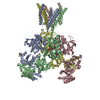 7saaC 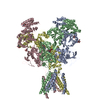 7sabC 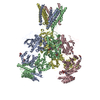 7sadC M: map data used to model this data C: citing same article ( |
|---|---|
| Similar structure data | Similarity search - Function & homology  F&H Search F&H Search |
- Links
Links
- Assembly
Assembly
| Deposited unit | 
|
|---|---|
| 1 |
|
- Components
Components
-Glutamate receptor ionotropic, NMDA ... , 2 types, 4 molecules ACBD
| #1: Protein | Mass: 95225.883 Da / Num. of mol.: 2 Source method: isolated from a genetically manipulated source Source: (gene. exp.)   Rattus norvegicus (Norway rat) / Gene: Grin1, Nmdar1 / Production host: Rattus norvegicus (Norway rat) / Gene: Grin1, Nmdar1 / Production host:   Spodoptera frugiperda (fall armyworm) / References: UniProt: P35439 Spodoptera frugiperda (fall armyworm) / References: UniProt: P35439#2: Protein | Mass: 98888.945 Da / Num. of mol.: 2 Source method: isolated from a genetically manipulated source Source: (gene. exp.)   Rattus norvegicus (Norway rat) / Gene: Grin2b / Production host: Rattus norvegicus (Norway rat) / Gene: Grin2b / Production host:   Spodoptera frugiperda (fall armyworm) / References: UniProt: Q00960 Spodoptera frugiperda (fall armyworm) / References: UniProt: Q00960 |
|---|
-Sugars , 2 types, 10 molecules 
| #3: Polysaccharide |  / Mass: 424.401 Da / Num. of mol.: 3 / Mass: 424.401 Da / Num. of mol.: 3Source method: isolated from a genetically manipulated source #4: Sugar | ChemComp-NAG /  N-Acetylglucosamine N-Acetylglucosamine |
|---|
-Non-polymers , 3 types, 5 molecules 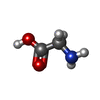
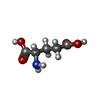
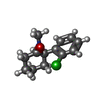


| #5: Chemical |  Glycine Glycine#6: Chemical |  Glutamic acid Glutamic acid#7: Chemical | ChemComp-JC9 / ( |  Esketamine Esketamine |
|---|
-Details
| Has ligand of interest | Y |
|---|
-Experimental details
-Experiment
| Experiment | Method:  ELECTRON MICROSCOPY ELECTRON MICROSCOPY |
|---|---|
| EM experiment | Aggregation state: PARTICLE / 3D reconstruction method:  single particle reconstruction single particle reconstruction |
- Sample preparation
Sample preparation
| Component | Name: Hetero-tetrameric GluN1a-GluN2B NMDA receptors / Type: COMPLEX / Entity ID: #1-#2 / Source: RECOMBINANT |
|---|---|
| Source (natural) | Organism:   Rattus norvegicus (Norway rat) Rattus norvegicus (Norway rat) |
| Source (recombinant) | Organism:   Spodoptera frugiperda (fall armyworm) Spodoptera frugiperda (fall armyworm) |
| Buffer solution | pH: 7.5 |
| Specimen | Conc.: 4 mg/ml / Embedding applied: NO / Shadowing applied: NO / Staining applied : NO / Vitrification applied : NO / Vitrification applied : YES : YES |
Vitrification | Instrument: FEI VITROBOT MARK IV / Cryogen name: ETHANE / Humidity: 85 % / Chamber temperature: 285 K |
- Electron microscopy imaging
Electron microscopy imaging
| Experimental equipment |  Model: Titan Krios / Image courtesy: FEI Company |
|---|---|
| Microscopy | Model: FEI TITAN KRIOS |
| Electron gun | Electron source : :  FIELD EMISSION GUN / Accelerating voltage: 300 kV / Illumination mode: FLOOD BEAM FIELD EMISSION GUN / Accelerating voltage: 300 kV / Illumination mode: FLOOD BEAM |
| Electron lens | Mode: BRIGHT FIELD Bright-field microscopy Bright-field microscopy |
| Image recording | Electron dose: 57.6 e/Å2 / Film or detector model: GATAN K3 BIOQUANTUM (6k x 4k) |
- Processing
Processing
| Software | Name: PHENIX / Version: 1.19.1_4122: / Classification: refinement | ||||||||||||||||||||||||
|---|---|---|---|---|---|---|---|---|---|---|---|---|---|---|---|---|---|---|---|---|---|---|---|---|---|
| EM software | Name: cisTEM / Version: 1.0.2 / Category: 3D reconstruction | ||||||||||||||||||||||||
CTF correction | Type: NONE | ||||||||||||||||||||||||
3D reconstruction | Resolution: 3.69 Å / Resolution method: FSC 0.143 CUT-OFF / Num. of particles: 434625 / Symmetry type: POINT | ||||||||||||||||||||||||
| Refine LS restraints |
|
 Movie
Movie Controller
Controller





 PDBj
PDBj









